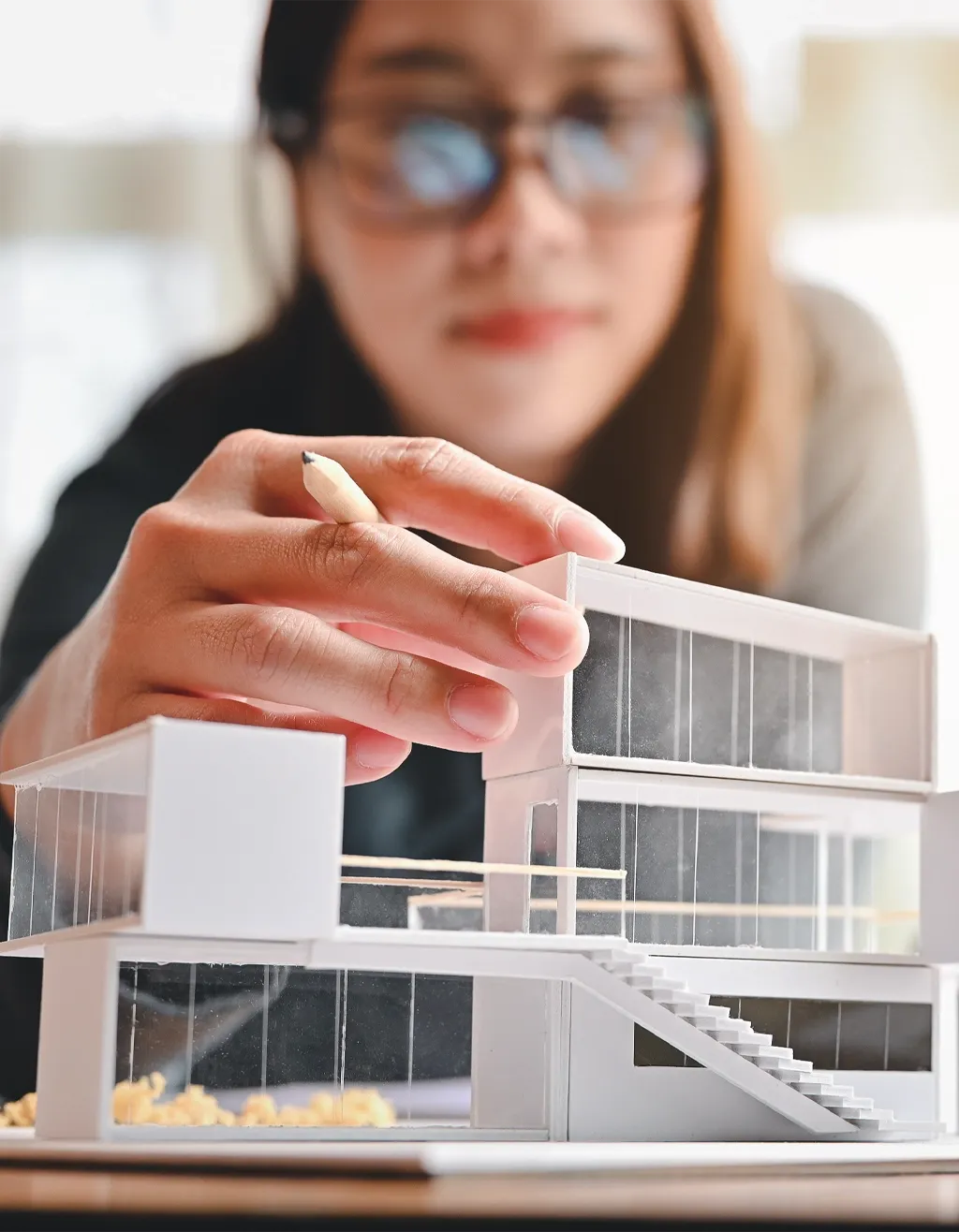Online MS in Sustainable Architecture
Master an eco-friendly, efficient approach to design and construction.
YOUR FUTURE STARTS HERE
Complete the form below to learn more about our online programs and how to get started.
The online Master of Science in Sustainable Architecture from OU Online empowers you to reimagine how buildings are designed. Through immersive case studies and direct insights from industry leaders, you will gain cutting-edge analytical tools that support smarter, evidence-based design decisions—and help you clearly communicate the value of sustainable choices to clients.
Explore the materials, methods, and strategies that shape truly sustainable environments, all grounded in real-world data.
This program does not lead to licensure as an architect.
15+ Months
30
10 to 20 Hours Weekly
Fall, Spring
The master’s degree in Sustainable Architecture delivers a high-impact return on investment. You will build advanced expertise that positions you for leadership roles and increased earning potential in the rapidly expanding field of sustainable design.
Tuition and fees total $30,450 ($1,015 per credit hour). This estimate does not include books or additional materials.
YOUR FUTURE STARTS HERE
Complete the form below to learn more about our online programs and how to get started.
The online Master of Science in Sustainable Architecture is a 30-credit program built for working professionals who want to lead the future of sustainable design. Delivered fully online, the degree can be completed in just 15 months. Expert faculty from the Gibbs College of Architecture guide you through advanced analytical tools and evidence-based strategies that go beyond surface-level “green” design.
Graduate prepared to meet the rising demand for architects and designers who create high-performance buildings, deliver measurable results, and clearly communicate their impact to clients.
This program isn’t a pathway to architectural licensure—it’s something more. Designed as a post-professional degree, it empowers experienced professionals to deepen their expertise in sustainable design. Whether you’re shaping cities, spaces, or systems, you’ll gain cutting-edge knowledge and practical skills to lead with purpose and innovate for a greener future.
Earning your master’s degree in Sustainable Architecture online from the University of Oklahoma prepares you to lead in sustainable construction and design. You’ll gain the expertise to accelerate your career in roles that demand both creative vision and technical precision, including:

OU’s online Master of Science in Sustainable Architecture meets the growing demand for professionals with the advanced skills and specialized knowledge to lead in sustainable construction and design.
Through this program, you will:
The Sustainable Architecture program delivers a powerful foundation in sustainable design, workflow optimization, and advanced building techniques. You will build in-demand skills in performance analysis and building physics—empowering you to design smarter, construct more efficiently, and lead projects that drive real environmental and economic impact.
Earn 30 credit hours across 15 courses, taking two courses per module (four per semester). Spring and Fall courses run 8 weeks, Summer courses 7 weeks.
Students attend one live lecture per week per course, typically starting at 7 p.m. CT and lasting 2 to 3 hours. Expect a weekly time commitment of 10 to 20 hours for two courses.
Credit Hours: 2
An introduction to environmental justice, including stakeholders and community engagement. A survey of how human comfort metrics intersect with site and climate. Introduces systemic issues associated with equity in the built environment and indigenous approaches.
Credit Hours: 2
An introduction to metrics for evaluating building performance and tools for evaluation. Explores performance targets such as the Architecture 2030 Challenge. Examines pre- and post-occupancy performance analysis tools, equipment, and methods. Introduces software such as Cove Tools, Autodesk Insight, and Sefaira.
Credit Hours: 2
An introduction to Building Information Modeling (BIM) sustainable design workflows. Explores how designers, engineers, and contractors collaborate through BIM to reach sustainable design goals. Examines how BIM can be used to drive sustainable design and decision-making in theory and practice.
Credit Hours: 2
An introduction to the US Green Building Council Leadership in Energy and Environmental Design (LEED) program. Examines how buildings can be designed and operated to reduce energy consumption, protect resources, and promote health through the LEED program. Prepares students to take the LEED Green Associate Exam.
Credit Hours: 2
Introduction to Life Cycle Cost Accounting (LCCA) and the Circular Economy. Explores the economic history, basic theory, and practices associated with LCCA. Examines connections between performative building design evaluations and sustainability's three "E's": Environment, Equity, and Economic factors. Considers the role of the architect in a global context and their interdisciplinary impact on sustainability.
Credit Hours: 2
Explores the realities of building impacts on the environment through sustainable design case studies. Introduces the case study method of analysis using the AIA Framework for Design Excellence. Introduces tools and methods for undertaking case study analysis of built works.
Credit Hours: 2
Explores examples of sustainable building design and construction through case study analysis following the American Institute of Architects case study format. Provides an opportunity for individual research project development. Includes consideration of sustainable design standards such as LEED and/or WELL.
Credit Hours: 2
Building on the Case Study Research course, case studies are developed through peer reviews and presentations. Publication venues are investigated.
Credit Hours: 2
An introduction to topics in building physics including indoor and outdoor climate, passive technologies, daylighting, water issues, psychrometrics, and heat transfer. Explores the scientific method and application with building performance analysis, simple software-based calculations used to evaluate designs and construction against codes and standards. Explores connections between site and sustainable building metrics, Zero Tool, and AIA Framework for Design Excellence.
Credit Hours: 2
An introduction to design research methods. Examines the application of quantitative and qualitative research methods to research questions in architecture and urban design from pre-design to post-occupancy evaluation. Explores the practice of evidence-based design.
Credit Hours: 2
An introduction to sustainable urban design principles and practices. Explores Geographic Information System (GIS) tools and EPA databases such as the TRI Explorer as they relate to sustainable urbanism, real estate, and equity. Introduces the Ecodistrict Accredited Professional program.
Credit Hours: 2
An introduction to the theory and practices associated with the WELL Building Standard. Explores the research on human health and the design of the built environment that forms the foundation for the WELL building program. Prepares students to take the WELL Accredited Professional exam.
Credit Hours: 2
This course will explore the Rocky Mountain Institute (RMI) "NZE Leasing Best Practice Guide" and ULI's "Blueprint for Green Real Estate" including the steps of how to write and negotiate an NZE lease with elements that include energy budgets, building dashboards, recommissioning, green building financing models, and BIM-enabled digital twins.
Credit Hours: 2
Introduces literature reviews in the context of architectural research questions. Explores design research methods and processes through a review of existing literature on a topic. Develops an understanding of how to identify gaps in existing knowledge.
Credit Hours: 2
This course prepares students to take the Comprehensive Examination, given at the end of the course, demonstrating: 1) their experience in secondary research in their area of program concentration; 2) their knowledge of the areas and subareas of the discipline and their position relative to these areas; and (3) their pedagogical knowledge, techniques and literature.

OU Online offers high-quality, affordable graduate and undergraduate programs in a flexible, fully online format—backed by the reputation of a top-tier public institution. With the Master of Science in Sustainable Architecture, you will gain the knowledge and skills to thrive in the fast-moving world of sustainable design and construction.
The master’s degree in Sustainable Architecture is powered by world-class University of Oklahoma faculty and enriched by professors of practice who bring real-world expertise into the classroom. By connecting industry leaders with our online programs, we deliver an advanced, future-focused curriculum that prepares you for long-term career success.
OU Online provides comprehensive student support services designed to help you succeed. Access academic support, online tutoring, mental health counseling, and a dedicated online career development center. The program is built to meet the needs of working professionals, allowing you to grow your technical expertise while maintaining full-time employment.
With more than 250,000 alumni across the world, becoming a Sooner means you’ll have access to a strong network of sustainable architecture professionals to accelerate your career. You’ll be part of a powerful network of leaders working in organizations across the world, helping you expand your career as a sustainable architecture professional.
The MS in Sustainable Architecture is delivered in a fully online, flexible format designed for working professionals across the globe. Earn your degree in as little as 15 months while managing full-time work and personal responsibilities. Study from anywhere and gain specialized expertise in sustainable architecture—on your terms, on your schedule.
Move through the program with a small, focused cohort of professionals who share your passion for sustainable architecture. Engage in dynamic online discussions with expert faculty and like-minded peers, build lasting connections, and grow a powerful network while developing the skills to lead in the sustainable design industry.

Earning your Master of Science in Sustainable Architecture is a smart investment in your future—and OU Online makes that investment clear, accessible, and student-focused.
Tuition is $1,015 per credit hour*, totaling $30,450 for the full 30-credit program. This estimate does not include books or additional materials.
You may qualify for financial aid, scholarships, or employer tuition assistance to help lower your out-of-pocket costs. Our dedicated financial services team will support you every step of the way, so you can stay focused on advancing your education and career.
For questions about financial aid for your online program, contact the Online Aid office at onlineaid@ou.edu or call 405-325-2929.
A nonrefundable deposit of $350 is required upon admission to secure your place in the program. This deposit guarantees your spot in your first semester of courses and will be applied toward your first semester’s tuition.
* Please be aware that tuition and fees may change, as determined by the Oklahoma State Regents for Higher Education.
Transfer credits will not be accepted from incoming applicants with courses from another institution.
The department will allow transfers from the current M.S. in Architecture program on campus at OU if a student believes the Sustainable Architecture program would lead to a better workforce outcome to accomplish their goals.
YOUR FUTURE STARTS HERE
Complete the form below to learn more about our online programs and how to get started.